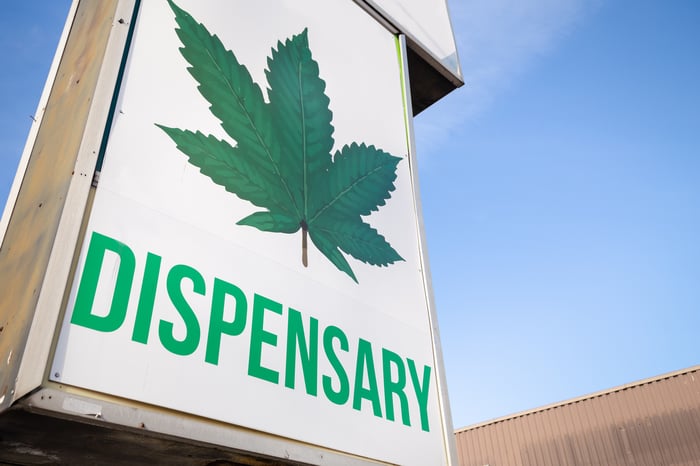There's no denying that marijuana represents one heck of an intriguing growth opportunity for investors. We've already witnessed global sales soar from $3.4 billion in 2014 to $10.9 billion in 2018, and they're on track to surpass $40 billion by 2024. Though growth estimates vary wildly, which is expected for an industry without any legal precedence, the consensus is that the pot industry should deliver double-digit compound annual growth for many years to come.
Unfortunately, these rosy forecasts haven't led to happy investors over the past six months. Through this past weekend, and inclusive of dividends paid, the Horizons Marijuana Life Sciences ETF, the first exchange-traded fund focused on cannabis, had fallen 40% since the end of March. Since this ETF contains around five dozen pot stocks of various weightings, it's pretty easy to see that this isn't a one- or two-company issue, but an industrywide beatdown.
The bad news is that this beatdown may continue for the foreseeable future for three cannabis stocks, which is what makes them wholly avoidable in the fourth quarter.

Image source: Getty Images.
Canopy Growth
Ironically, the biggest train wreck in the entire marijuana industry might arguably be Canopy Growth (CGC 15.03%). Sure, it's the largest pot stock in the world, and yes, it has more cash on its balance sheet than any other cannabis company. But size and cash alone don't make for a solid investment thesis.
In Canopy's fiscal first-quarter operating results, we got a good glimpse of just how bad things are. The company's gross margin managed to sink to an abysmal 15%, aided in part by underperforming and under construction grow farms, as well as falling per-gram dried flower pricing. Like most growers, Canopy Growth is contending with supply problems in Canada that aren't going to be resolved anytime soon. The result, for two consecutive quarters now, has been relatively flat marijuana sales.
This is a company that's also losing an exceptional amount of money. Even if we take out the absurd 1.18 billion Canadian dollar charge for the extinguishment of warrants in the fiscal first quarter, Canopy's operating expenses more than tripled to CA$229.2 million, completely dwarfing its CA$13.2 million in gross profit, before fair-value adjustments. This is just a nice way of saying that Canopy Growth is nowhere near recurring profitability, and may not be until 2022, at the earliest.
Investors would be wise to also not forget that Canopy's board of directors fired its visionary co-CEO Bruce Linton in early July. This was a moved deemed necessary given the company's ballooning losses. However, with current CEO (and former co-CEO with Linton) Mark Zekulin stepping down once a permanent CEO solution is found, the company is sort of a rudderless ship at the moment.
As the icing on the cake, Canopy's goodwill continued to rise in the first quarter to CA$1.93 billion, increasing the likelihood of an eventual writedown.
Long story short, don't be suckered into this brand-name pot stock during the fourth quarter.

Image source: Getty Images.
MedMen Enterprises
Another popular cannabis stock that investors would be wise to avoid like the plague in the fourth quarter is vertically integrated multistate operator MedMen Enterprises (MMNFF).
On the surface, MedMen has some admirable attributes. Its branding does seem to be resonating with its affluent clientele, and the company has a presence in a number of top-tier legal U.S. states. Further, it's in the process of acquiring PharmaCann in an all-stock deal that'll double the number of states it has a presence in, as well as vault it to the No. 2 spot in terms of operational retail locations. Sounds great, right?
The problem is that while many of its peers have been whittling away at their costs as revenue expands, MedMen's expenses just keep ballooning. Even with the company on track to reduce general and administrative expenses by 30% in the fiscal fourth quarter from the December 2018-ended quarter, according to a preliminary Q4 update, MedMen has reported an unsightly $178.4 million in operating losses through the first nine months of fiscal 2019. That's far and away the biggest operating loss of any multistate dispensary operator.
And by the looks of things, MedMen's operating costs aren't going to dip substantially anytime soon. It's aggressively expanding into the Florida market, and assuming its deal to acquire PharmaCann gains regulatory approval, it'll then have to contend with PharmaCann's existing operating and expansion costs.
Yet another hurdle for MedMen is that its deal to acquire PharmaCann is being completed entirely by issuing its own stock. In other words, MedMen is going to dilute its existing shareholders and very likely overpay for PharmaCann to make this deal happen.
Like Canopy Growth, MedMen is a long way from generating a recurring profit, and it deserves to be avoided by investors until it makes significant progress on its bottom line.

Image source: Getty Images.
Tilray
The third and final pot stock that should be avoided at all costs by investors in the fourth quarter is Canadian grower Tilray (TLRY). Although Tilray has lost more than 90% of its value since its moon shot to $300 on the nose in mid-September 2018, it's still far from a value.
Perhaps the biggest factor working against Tilray is its March-announced shift away from focusing investments on Canada and, instead, shifting future investments to the United States and Europe. Though these markets do offer significant promise, the timing of its shift away from the only industrialized country in the world to have legalized recreational marijuana in favor of markets that are more confining is a bit of a head-scratcher.
Just as troubling is the likelihood that Tilray will struggle to expand its margins as quickly as its peers. You see, in March it acquired hemp foods company Manitoba Harvest in order to gain access to Manitoba's retail distribution network of 16,000 retail stores throughout North America. This distribution system could prove worthwhile when launching a line of cannabidiol products in the United States. Unfortunately, hemp foods is a much lower-margin product than cannabis, and it's liable to be a drag on Tilray's gross margin. Over the past three quarters (from Q4 2018 through Q2 2019), gross margin has been a relatively anemic 20%, 23%, and 27%, respectively.
But it's not just hemp food product sales that are hindering Tilray's margins. This is also a company that's not been up to snuff on production expansion, and as a result has needed to acquire marijuana from other growers at wholesale pricing. These ongoing wholesale purchases are killing Tilray's margins, and it's unclear when the company will be generating enough of its own output to meet demand.
As is the case with the other two companies above, Tilray has virtually no shot of near-term profitability. If the company executes flawlessly from this point on, it may turn a profit by 2021. Thankfully, there are far better cannabis stock options for investors to choose from rather than waiting around for Tilray to get its act together.





